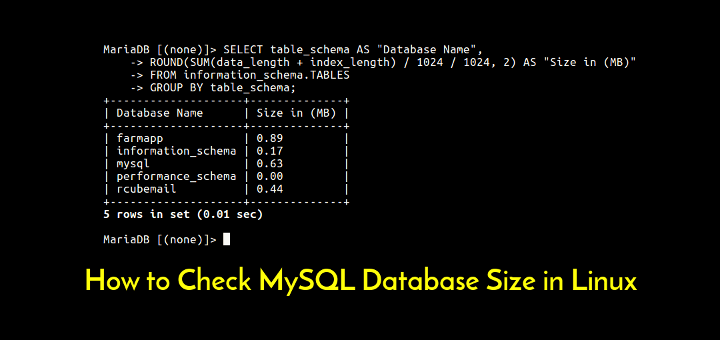
(This applies to statements terminated by or \G.) This option was added in MySQL 5.5.3. Completion does not occur if there is no default database.Ĭause result sets to display vertically if they are too wide for the current window, and use normal tabular format otherwise. Otherwise, press Tab again to see the possible names beginning with what you typed so far. If the name is unambiguous, mysql completes it. To complete a name, enter the first part and press Tab. That causes mysql to start faster, but you must issue the rehash command if you want to use name completion. Use -disable-auto-rehash to disable rehashing. This option is on by default, which enables database, table, and column name completion. Mysql supports the following options, which can be specified on the command line or in the and groups of an option file.
#Centos mysql show databases how to
and after prompting you for your password, mysql would execute the commands in mysqlscript.txt on the database db_name, writing the output to the file output.txt.įor an in-depth description of how to install MySQL on your system, and an overview of the basic interactive usage of mysql, see an introduction to MySQL. For instance, if you have a text file named mysqlscript.txt containing MySQL commands, one per line, you could use this command: mysql -u username -p db_name output.txt Instead of using mysql interactively, you can execute MySQL statements from a script file.

To end your mysql session and return to the shell prompt, use the command: mysql> QUIT Running MySQL commands from a batch script to display the mathematical product of 2 and 21. to begin using the database named dbname, or: mysql> SELECT 21 * 2 AS meaning_of_life To list the databases which exist, or: mysql> USE dbname You are shown a brief introduction message and then placed at the mysql> prompt.Īt the mysql> prompt, enter MySQL commands, such as: mysql> SHOW DATABASES
#Centos mysql show databases password
The simplest way to invoke mysql is to specify your MySQL username with the -u option, and to tell mysql to prompt you for your password with -p: mysql -u username -p The output format can be changed using command options. When used non-interactively, the result is presented in tab-separated format. Uptime: 1001300 Threads: 1 Questions: 11923946 Slow queries: 0 Opens: 701 Flush tables: 2 Open tables: 260 Queries per second avg: 11.When mysql is used interactively, query results are presented in a table format.

Here’s another method to check the status of MySQL server: $ mysqladmin -u root -p status My favorite is the systemctl method since I use it often to check the status of other services like httpd. └─26125 /usr/libexec/mysqld -basedir=/usr -datadir=/var/lib/mysql -plugin-dir=/usr/lib64/mysql/plugin -log-error=/var/log/mariadb/mariadb.log -pid-file=/var/run/mariadb/mariadb.pi. ├─25949 /bin/sh /usr/bin/mysqld_safe -basedir=/usr

Loaded: loaded (/usr/lib/systemd/system/rvice enabled vendor preset: disabled)Īctive: active (running) since Thu 07:59:30 EDT 1 weeks 4 days ago Redirecting to /bin/systemctl status rvice

Here are a few ways to determine if MySQL is running on a CentOS 7 or Red Hat 7 Linux box. While my answer was not wrong, I quickly realized there were better ways to find out if MySQL (or MariaDB) is running on a Linux box (in my case, CentOS 7).


 0 kommentar(er)
0 kommentar(er)
